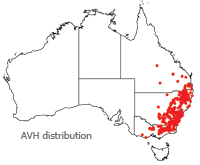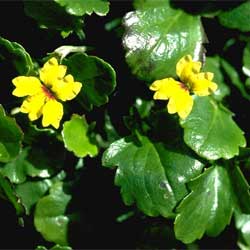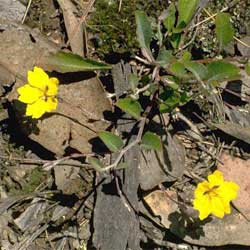Goodenia hederacea
Ivy Goodenia
 Goodenia hederacea (Ivy Goodenia) belongs to the Goodeniaceae family, which contains 11 genera and approximately 400 species, almost all of which are confined to Australia and New Guinea. Goodenia hederacea occurs from southeastern Queensland to eastern Victoria, and grows in forest to alpine woodland and grassland. It is also widespread along the coast . Two subspecies are recognized – Goodenia hederacea subsp. hederacea and G. hederacea subsp. alpestris.
Goodenia hederacea (Ivy Goodenia) belongs to the Goodeniaceae family, which contains 11 genera and approximately 400 species, almost all of which are confined to Australia and New Guinea. Goodenia hederacea occurs from southeastern Queensland to eastern Victoria, and grows in forest to alpine woodland and grassland. It is also widespread along the coast . Two subspecies are recognized – Goodenia hederacea subsp. hederacea and G. hederacea subsp. alpestris.
Goodenia hederacea is a prostrate to ascending perennial herb. Its long trailing stems often root at the nodes, grow up to 80cm long, and are cottony hairy. Leaves are irregularly toothed, non-hairy above, and often non-hairy or cottony below. Fruit is ovoid (egg shaped) and 5-9mm long. Flowers are deep yellow, 8-15mm long and arranged in a terminal leafy raceme.
Goodenia hederacea is horticulturally desirable as it is quite easy to establish and grow, extremely attractive (it particularly looks good in hanging baskets), drought tolerant, frost resistant, requires little maintenance, grows in most soil conditions (including dry areas), and can be used for bordering paths or as a ground cover.
Although Goodenia hederacea can grow in most soils, moist well-drained soils are preferable. It can grow in heavy shade or full sun. Flowering occurs in spring and summer; and fruiting time is in autumn. Propagation of Goodenia hederacea is by cuttings or division, but most commonly by division. It is generally fairly easy to strike. Both cuttings and divisions should be grown in a relatively light soil mix; to give better water and air flow and stop any rotting from occurring.
For the division method, simply dig up and divide the plant carefully, as it is important to prevent any unnecessary damage to plant tissue. Each division should have healthy young roots, to be able to provide food for the foliage . Hygiene is also very important; a recommended procedure is to thoroughly drench the soil area in and around the plant with a fungal drench or root stimulant. The best time to divide plants is when new roots are beginning to form, usually after a growth flush . It is also better to do before or after flowering, so that the plant can put more energy into recovering after division. While dividing plants, it is important to always keep foliage and roots moist . It is also important to give the plant a good watering afterwards.
For cuttings, it is preferable to u se newer growth, as they will have a better chance of taking. Using a light root hormone application will cause roots to form a lot quicker. Cuttings also tend to grow well in a sandy well-drained soil.
There appears to be few limitations to cultivation. Goodenia hederacea is generally easy to establish and even appears resistant to insectivorous pests and grazing herbivores such as kangaroos and rabbits. Goodenia hederacea is quite hardy, and once established it requires little maintenance. It’s just important to water it occasionally, hand-weed around the plant when needed and use a light layer of mulch to prevent weeds.
Text by Caroline Wilson (2008 Student Botanical Intern)
Name Meaning: Goodenia hederaceaGoodenia – after Samuel Goodenough (1743-1827), botanist, and vice president of the Royal Society of London. hederacea – derived from hedera (referring to ivy); because Goodenia hederacea has long trailing stems, similar to that of ivy. |
References
Australian Plants Society Maroondah, Inc. (2001) Flora of Melbourne: A Guide to the Indigenous Plants of the Greater Melbourne Area. Australian Plants Society Maroondah, Inc., Melbourne.
Australian Plant Study Group (1987) Grow What Small Plant. Nelson Publishers, Melbourne.
Blake T. (1976) Goodeniaceae. Society for Growing Australian Plants, Maroondah Group.
Carolin R. C., Rajput M. T. M. and Morrison D. (1992) Flora of Australia Volume 35, Brunoniaceae, Goodeniaceae. Australian Government Publishing Service, Canberra.
Fethers, S. (1998) Australian National Botanical Gardens, Canberra. Personal communication.
Harden G. J. (1992) Flora of New South Wales Vol. 3. New South Wales University Press, New South Wales.
Hyam R. and Pankhurst R. (1995) Plants and Their Names: A Concise Dictionary. Oxford University Press, Edinburgh.
Marchant J. R. V. and Charles J. F. (1946) Cassell’s Latin Dictionary: Twenty Fourth Edition. Cassell and Company.
Society for Growing Australian Plants, Canberra Region Inc. (1973) Australian Plants for Canberra Gardens and other Cool Climate Areas. Canberra Times Print.
Walsh, N.G. & Entwisle, T.J. (1999) Flora of Victoria, Volume 4: Dicotyledons – Cornaceae to Asteraceae. Inkata Press, Australia.
Wrigley J. W. and Fagg M. (2007) Australian Native Plants: Cultivation, Use in Landscaping and Propagation. New Holland Publishers, Australia.
![An Australian Government Initiative [logo]](/images/austgovt_brown_90px.gif)



